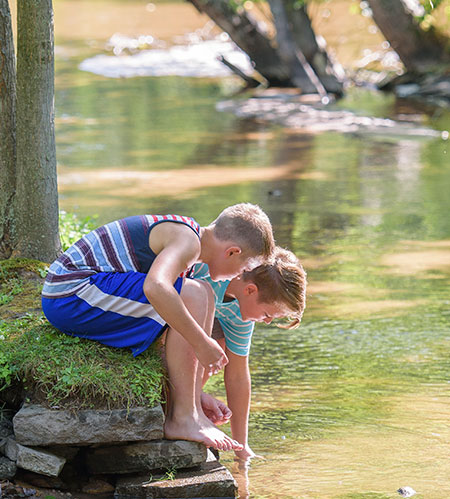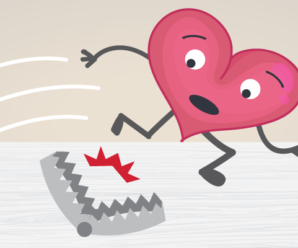Every summer families flock to lakes, rivers and streams for fun in the water. Water safety is even more important outdoors because of the unpredictability of these flowing waters.

Swimming in natural waterways have different risks than pools. Most should be wearing U.S. Coast Guard approved life jackets, but also check your surroundings for hazards before you get in can improve water safety.
Swim with supervision
If you have older children or teens who swim on their own, have them tell a friend or family member when they are out on the water, where they plan to go and what time they will return. Elizabeth Chacko, M.D., pediatrician with Marshfield Clinic Health System, said even children with swimming skill should have an adult supervising closely and continuously without distraction like reading or using a phone.
“Keep in mind that swimming lessons do not provide ‘drown-proofing’ for children of any age, so supervision and other layers of protection are necessary, even for children who have learned swimming skills,” she said.
Dr. Chacko says teach your child to swim when they are ready. Some children may be ready as early as one years old, but all children should have the opportunity to learn swim skills by age 5.
Dangers in lakes, rivers and streams
The American Red Cross recommends checking for these potential dangers before swimming:
- Underwater hazards. Enter water carefully, especially if you cannot see the bottom. You may find sharp stones, debris, slippery rocks or weeds that can entangle your limbs.
-
- Consider wearing special water shoes to protect your feet and prevent slipping.
- Water depth.You can be severely injured jumping or diving into water of unknown depth. Do not dive unless you know the water is more than nine feet deep and has no underwater obstacles.
- Shallow water can quickly drop off into deeper water and take even strong swimmers by surprise.
- Do not let young children and children who cannot swim use inflatable toys, water wings, or mattresses in water that is above the waist. These are toys, not safety devices.
- Fast-moving water. Currents, waves and rapids can sweep you away or pull you underwater without warning, even in shallow water. Water that appears calm on the surface may be turbulent below.
- Ask a park ranger or someone familiar with the area about water conditions. Wear a life jacket and swim in a calm area.
- If you swim or drift far from shore, stay calm and tread water, or float on your back until help arrives.
- Boaters. Be aware of other people’s activity on the water, especially boating. Swim in areas without boat traffic, like a designated swimming area at a public beach. For example, when swimming near your own boat, make sure the engine is off before you enter the water. Never swim under a boat.
- Changing weather. Check the weather before you head for the water. Leave the water immediately if you see thunder or lightning and head to shelter indoors or in your car. If you cannot get indoors, avoid open areas, isolated tall trees and metal objects.
- Carry warm, dry clothing for each family member to change into if the temperature suddenly drops.
- Contaminated water. Water can become contaminated by sewage, animal waste and runoff. Avoid swimming in natural waterways after heavy rainfalls or if your local health department has issued a water quality warning. Do not swallow water while you are swimming.
- Contact your doctor if you experience eye or ear problems, sore throat, diarrhea, trouble breathing or rash after swimming.
Emergencies in natural waters
If someone is in trouble in the water, call 911.
If you can help others, keep yourself safe by wearing a life jacket. Try to reach for the person using an object to extend your reach. Brace yourself so you don’t fall in. You also could throw a floating object to someone who is out of reach. Try to find something with a rope attached to pull the person to safety.
If water is shallow and calm, wade into the water and reach toward the person with an object to pull them to safety. Don’t enter water with strong currents or waves.
Water safety for lakes, rivers and streams
Additional tips that Dr. Chacko shared for swimming indoors or outdoors include:
- Learn CPR. Anyone caring for or watching children should know CPR (cardiopulmonary resuscitation). CPR can save a life and help reduce injury after a near drowning. The American Red Cross, the American Heart Association, and your local hospital or fire department offer CPR training.
- Always have a phone nearby. Clearly post or share your local emergency phone number (usually 911).
- Make sure all rescue equipment is nearby. This includes a shepherd hook, safety ring and rope.
This summer, Dr. Chacko recommends a saying from U.S. Environmental Protection Agency, “remember to Slip! Slop! Slap! and Wrap! when you’re outdoors.”
- Slip on a shirt.
- Slop on sunscreen of SPF 15 or higher
- Slap on a hat
- Wrap on sunglasses.
For more water safety tips, talk to a Marshfield Children’s provider.
Schedule appointment Message your provider
Related articles
Be safe on the water: Simple steps to ensure proper life jacket fit






Leave a Reply